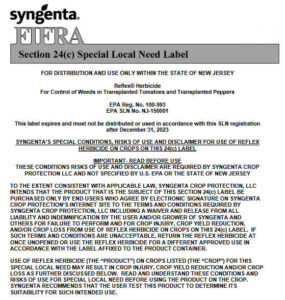
A 24(c) Special Local Needs label has been recently approved for New Jersey for use of Reflex herbicide for Control of Weeds in Transplanted Tomatoes and Transplanted Peppers. The use of Reflex 2SL is legal ONLY if a waiver of liability has been completed on the Syngenta website (https://www.syngenta-us.com/labels/indemnified-label-login).
Reflex is a selective preemergence herbicide for broadleaf weed control with both soil and foliar activity, but it is only labeled for preemergence use in transplanted peppers and tomatoes. The active ingredient in Reflex is fomesafen, a PPO inhibitor and the only herbicide in this family labeled for peppers and tomatoes. Broadleaved weeds are the main targetted species of this herbicide, that also activity on nutsedge. Expect excellent control of pigweed, (including Palmer amaranth), common ragweed, nightshade, and common purslane, acceptable control of common lambsquarters, morningglories and galinsoga, and suppression of field bindweed and nutsedge at the rate labeled for transplanted tomatoes and peppers. Use of a surfactant will improves postemergence control of susceptible annual broadleaf weeds. Note that annual grasses and some annual broadleaf weeds, including spurred anoda or horseweed, will NOT be controlled by Reflex 2SL.
[Read more…]

 When you’re working in the heat, safety comes first! With the OSHA-NIOSH Heat Safety Tool, you have vital safety information available whenever and wherever you need it – right on your mobile phone – for planning outdoor work activities based on how hot it feels throughout the day. Featuring real-time heat index and hourly forecasts, specific to your location, as well as occupational safety and health recommendations from OSHA and NIOSH.
When you’re working in the heat, safety comes first! With the OSHA-NIOSH Heat Safety Tool, you have vital safety information available whenever and wherever you need it – right on your mobile phone – for planning outdoor work activities based on how hot it feels throughout the day. Featuring real-time heat index and hourly forecasts, specific to your location, as well as occupational safety and health recommendations from OSHA and NIOSH.